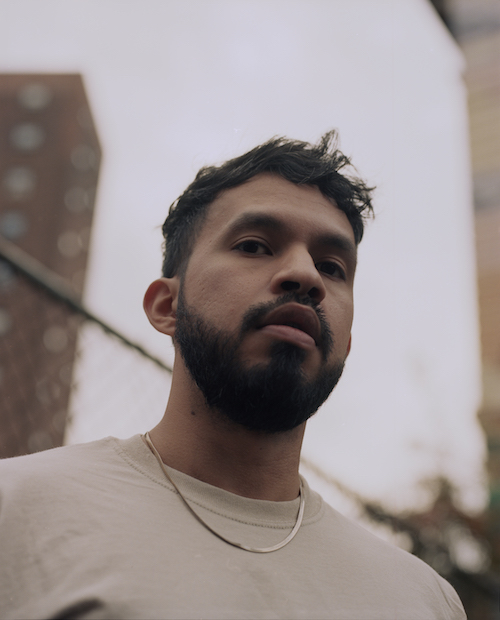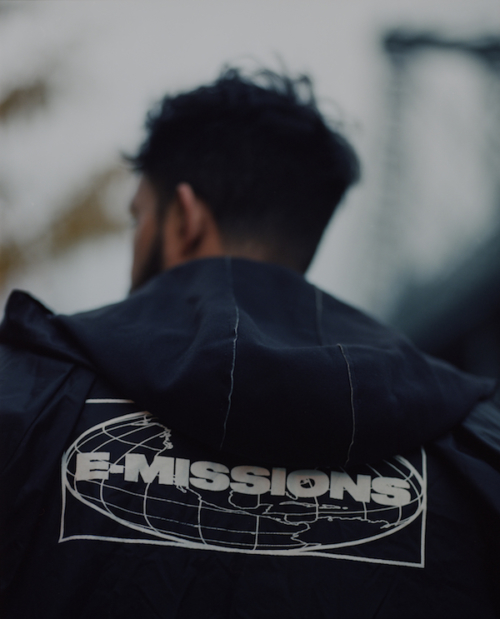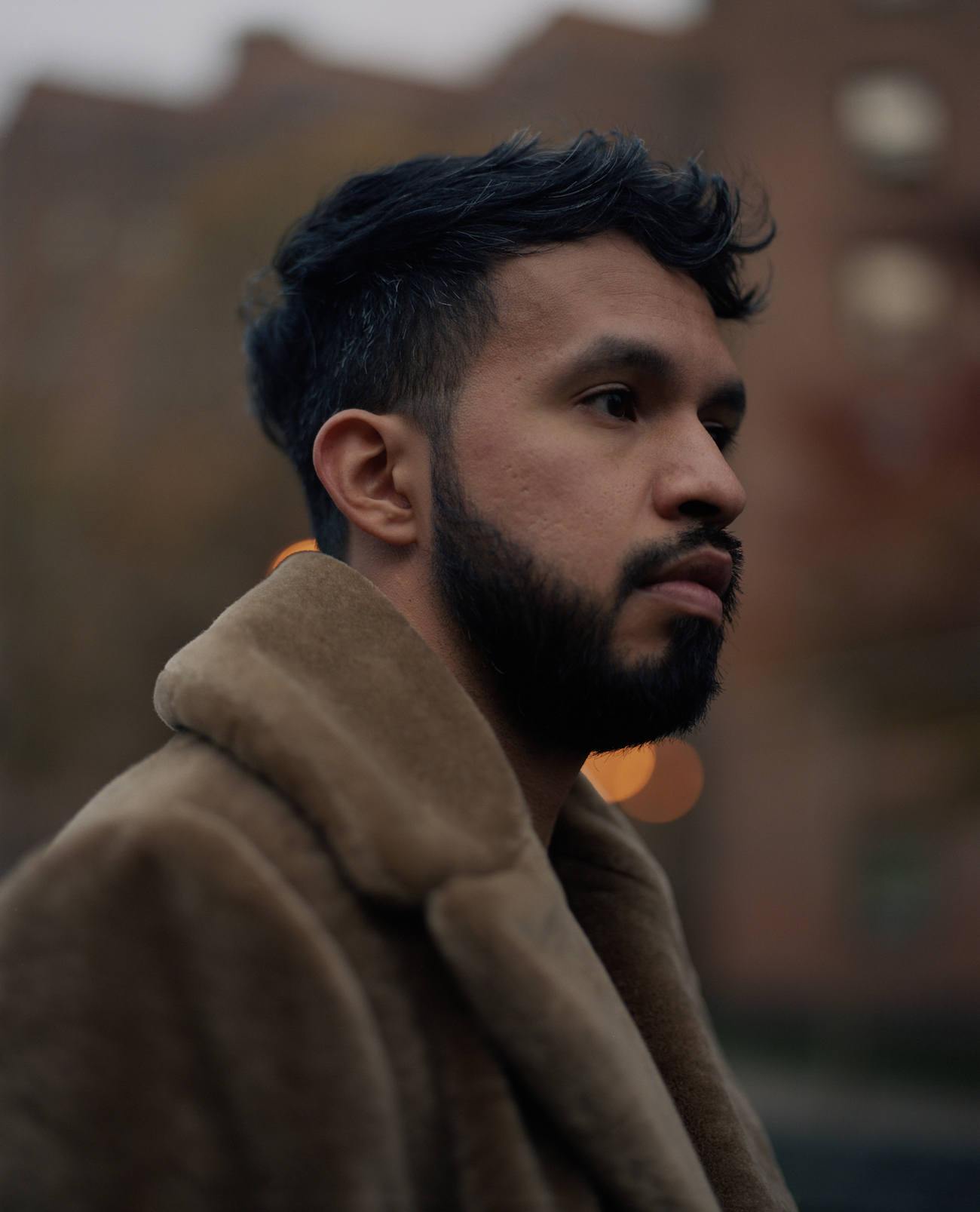The discussion around the music scene in the States and how it lacks the recognition and support that Europe gets is something that has been brought up a lot recently. Some of the most exciting collectives, artists, labels and agencies are coming from America, yet the time it takes them to receive the support they deserve is completely mind-blowing especially compared to their contemporaries in Europe. It’s a vibrant pocket of incredible talent, especially now more than ever, with artists experimenting with how and where they share their music and that can be said of visual artist and composer False Witness – real name Marco Gomez.
Moving to New York in 2014, Marco soon became immersed in the nightlife scene there, landing a residency at the iconic night club GHE20G0TH1K and joining the KUNQ collective. Transitioning their music into the art world, Marco has shown work and performed at institutions such as MoMA PS1, The New Museum, Frieze London, the Venice Biennale and SXSW. Over the years, Marco has released a handful of EP’s and remixes for the Physically Sick and Gays Hate Techno compilations, remixed Ariel Zetina & London Jade and held a monthly residency as Bossa Civic Club in collaboration with their ‘In The Dark’ EP. Attracted to the chaos of club culture, their mixes are often fast-paced and filled with high energy – frequently teaming up with Discwoman’s SHYBOI for their FALSEBOI project. Signing to New York’s E-Missions label (now moved to Berlin), founded by P.Leone and CAIAZZO, Marco kicks off the year with a heavy release that moves them further towards the techno world.
With ‘Red Curtain Daybreak’ due to be released tomorrow, we speak to Marco about finding their identity, dealing with masculinity, the concept behind the new EP and how they translate their music into the art world.
How did you get started in electronic music? Were there any other aspirations before pursuing a career in music?
I was studying to be a pharmacist for undergrad while I taught myself to DJ and produce music in my spare time. I really enjoyed learning about the biochemical mechanisms of the human body and how they interact with drugs. Ultimately though, the schooling itself continues to drown me in student loan debt, and I found the career prospects far too dry, depressing and exploitative. The Healthcare industry in the USA is frightening. I tried to keep a job as a pharmacy tech as a side hustle for a few years until 2014 when I made the move to NYC. At that point, I was deep into producing and DJing as False Witness. I had just played at my first GHE20G0TH1K, and everything at the time was pointing towards making the big leap forward, so I jumped into music and art full time.
Is your family interested in music? If so, what sort of music were they sharing with you as you were growing up?
I grew up listening to everything that my older sister would share with me: tapes and CDs of Aaliyah, Crystal Waters, Janet Jackson, The Real McCoy, The Prodigy, The Chemical Brothers. Hearing Daft Punk for the first time on Boston’s late-night alternative radio was how I discovered the term “house music”. By 13, I was sneaking out of my house at night to raves across state lines. I received the rest of my musical education at places like The Asylum in Springfield, MA, The Municipal Cafe in Hartford, CT and random trips to New York City.

What was it like in the beginning for you when it came to looking for inspiration and other artists that you could identify with? Did being with a collective like KUNQ help find your space within the electronic music world or perhaps even smaller, the techno scene?
KUNQ helped me identify a path to developing my own taste and political ideology as an artist. KUNQ emerged formally as a collective after 2008 as an experimental approach to power-sharing and mitigating privilege dynamics amongst a group of musically inclined queer people. KUNQ parties like Rizzla and Battyjack’s NULIFE was so much more than a singular genre, too. It was Nina Simone in conversation with Lady Saw, Lil Kim mixed with Innercity, Jay Karan, La Bouche, the list goes on. Musically, it touched on so many things but with such a cohesive vision of queer liberation. I couldn’t find any community with what I call ‘Techno’ today until I moved to New York City, where the definition of Techno is, thankfully, a lot looser and a great deal more experimental.
You’ve recently discussed how you’ve been dealing with performing masculinity and what it actually means – do you find that this journey reflects into the mood of your productions and sets?
Absolutely. Becoming radically aware of your gender means problematizing things and doing your best to work through it or risk becoming a problem or complacent with injustice. Everything about what is accepted as “masculinity” that pervades the society and popular culture is 100% toxic. But that doesn’t mean masculinity in of itself is wrong. As someone who’s affirmed with themselves that they are mostly masculine of centre, what is the alternative? How I do forge a masculinity of my own that isn’t violent? I think that all my work is inadvertently imbued with that sense of anxiety, yearning, and contemplativeness. I make and play the music I need to dance to.
In 2016, you said your EP ‘Rapture Punks’ was about dealing with trauma and a particularly dark time in your life. Everything from the music to artwork showcased this. What was the drive behind your next release ‘Red Curtain Daybreak’?
I’m happy looking back now at the Rapture Punks EP as this singular performance instead of a traditional EP release. It was a very healing and reflective body of work. I really wanna thank SHYBOI, Battyjack, and FXWRK for all their artistic contributions to that event. Red Curtain Daybreak, on the other hand, is something less about my own personhood and more about the nightlife environments developing in Brooklyn. I wanted to make something that soundtracked the aesthetic that I was seeing around me.
Lauren Berlant’s ‘Cruel Optimism’ is a key influence for the EP, how have you translated that into sound? Also why was it fitting for you to explore this idea within your music now?
I was introduced to Berlant’s work in 2017, around the time I began questioning certain ideas about nationalism, citizenship, identity, and belonging. The song was made around that time when I was navigating that feeling of detachment from that “object of desire”: the neoliberal manufactured idea of needing to belong to a specific group, allegiance to imaginary borders, etc. Taking the titles of radical theory as track names is something I learned to do from Rizzla, such as their works ‘Iron Cages’ and ‘Black Jacobins’. I’m pointing directly for my audience in the direction of my ideological inquiries.
Do you have a particular process when it comes to your productions or does each release happen quite spontaneously when / if the idea comes to you?
Some tracks are made in a day, others take months. Some fuse together and become entirely different entities. I read tarot card spreads like one would use Oblique Strategy cards. My workflow constantly fluctuates.
This is your first release with E-Missions, a New York based imprint. How did your relationship begin with the label?
I reached out to P.Leone this summer after discovering his music. We finally met in the fall in Brooklyn at his E-Missions opening party for BEMF, along with Chris Caiazzo, producer and co-founder of E-Missions, and Alex Seamens, who helped us craft the Fornasetti vase cover art. Their support for me and the record has been awesome.
You ran a monthly club night in 2018 at Bossa Civic Club called ‘In The Dark’, tied to your EP release with the same name, what kind of challenges did you face having to play the same space monthly? How did you ensure each night was different?
I teamed up with DJ Wawa to get a monthly spot at Bossa Nova where we could bring artists from across various practices together over a pair of CDJs and see what would happen. With that as our guiding principle, it wasn’t hard to create something special each time. Everyone we’ve booked has done something incredible and different. Some of my favourite past guests for ITD include artists like Kevin Beasley, Maria Chavez, Bergsonist and Cryptolect, who all have such distinct artistic practices in other mediums. Watching them craft these beautifully woven sets with the same level of mastery as their other practices were inspirational and iconic. DJ Wawa continues to hold down the night at Bossa during my absence alongside new resident Olga of Unter fame.

What attracts you to the chaos of club culture?
Partying here in Los Angeles this winter has me shaking off that creeping cynicism and jadedness that can come from being in a particular city’s nightlife scene for too long. I’ve had a few hands in the air dancefloor moments lately. I went out with friends this past weekend to Full Frontal Disco and the DJ dropped George Michael’s Freedom! ’90. The whole room erupted. I cried and hugged my roommate. That element of surprise is still there for me; it’s what keeps me going. When it happens, it’s bliss.
Over the years you have showcased your work at art institutions across the world including Frieze London, MoMA PS1, The New Museum and Venice Biennale and ‘Red Curtain Daybreak’ sets out to soundtrack your experience of the new light and space movement in Brooklyn. What makes art spaces a great environment for your work?
Once, a gallerist at Frieze stormed up to me during the middle of a performance and demanded I turn the music off. I was grabbing another record when they very irately yelled at me that “this (the fair) was not some rock show!!.” I just stared back, smiled, and cued the record in my hand. Dance music scares the art world. To them, its an accessory: fun for parties but it’s not “high art”. Yet it’s ironic that constantly challenging that notion has granted me the most access to the art world. I wouldn’t have had any of those opportunities if I kept my music strictly “in the club.”
Was your first experience of the light and space movement and what drew you to it?
Friends of mine like Kip Davis and Michael Potvin have really developed some uncanny LED art in the past 5 years and have begun to mentor others as well. Especially Kip, who I worked for as an assistant operating lights for a few events this past year. I remember being introduced to Dan Flavin and James Turrell installations some years back. Kip definitely has mentioned Flavin as an influence. At Bard, I was introduced to the works of Helio Oiticica and Robert Irwin. Experiencing the Helio Oiticica retrospective at the Whitney Museum and his influence on music, literature, and photography made me want to translate my sound into other mediums.
Do you notice any difference between the crowds that attend your club sets and art gallery performances? If so, what are some of the differences and is there a crowd you prefer playing too?
Jenny Schlenzka of Performance Space NYC recently wrote about Berghain being a model for art spaces to learn from. It’s an interesting proposition that I think could blur the lines of what constitutes audience participation further. I don’t think I have any preference because every situation is inherently different and should be seen as a unique opportunity to do something provocative. No matter the setting, I wanna leave something for the audience to reflect on long after I’m done playing.
Could you describe to us what your perfect performing environment would be?
I would say there’s no singular perfect space for what I do since I’m a bit of a chameleon and adapt to the space versus demanding that the space conform to my work. I’m low-key tired of the site specific installation mentality. I do enjoy certain attributes that I think are conducive to getting an audience in the right mindset: a dark room. Light should be something structural, minimal. I prefer a DJ booth off to a corner and at floor level instead of a centered and elevated stage. Something of an architectural combination of the original Spectrum that existed in Williamsburg and OiL in Shenzhen, China is fun to envision.
You often play alongside SHYBOI under the alias FALSEBOI. What do you enjoy the best about playing with SHYBOI and how does she feed your creativity?
Well, she has impeccable taste and an amazing sense of composition and arrangement. I like to think she and I process music and sound in a similar fashion, so our sets together are pretty magical. Although we travel in opposite directions of the world a lot of the time, we’ve managed to clock in some studio hours to produce a few tracks together as FALSEBOI, as well as play, shows together. I play our tracks pretty regularly. There’s no rush on releasing them until we find a label that’s a right fit. I would love it if we toured together. I’m really hoping we can get to do that soon.
What do you hope to achieve this year?
I hope to do as much as I possibly can.
‘Red Curtain Daybreak’ by False Witness will be released on E-Missions on the 8th February – pre-order here.
